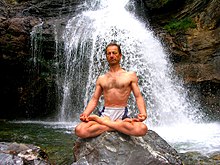Asana
Asanas (Sanskrit आसन āsana, German 'n., the seat') are predominantly resting body positions in yoga (especially in Hatha Yoga). Asana is the 3rd stage of Raja Yoga (or Ashtanga Yoga or Kriya Yoga) according to Patanjali. The other seven stages of Raja Yoga are Yama, Niyama, Pranayama, Pratyahara, Dharana, Dhyana and Samadhi. Karanas (Sanskrit करण IAST karaṇa, German 'activity') are the sequences of movements in Hatha Yoga.
Important in the practice is the conscious going in, the right breath, conscious holding and the conscious dissolving of the asana. Yoga asanas should always contain two qualities in their execution: Stability and well-being (sthira-sukham asanam. Yogasutre 2.46).
It is useful to perform asanas specifically designed to strengthen the muscles, or those that prepare more difficult ones, dynamically in the rhythm of the breath. Asanas serve not only physical suppleness and vital strength, but also good body control; they harmonize body and mind (see also: breathing exercises).
However, Yogasutre 2.47 adds : 'prayatna-śaithilyānanta-samāpattibhyām' : The posture (asana) is mastered by letting go of tension and meditating on the Infinite (Ananta). Complete asana thus goes beyond the physical sense of the exercise.
Yoga and the asanas are based on physical experience, where practical performance is more important than theoretical knowledge of the various effects. One of the intended effects is to calm the flow of thoughts. This is more successful if only the most necessary things are spoken during the practice and a passive "letting happen" is allowed - the opposite of gymnastic exercises, which are also health-promoting, but mostly performance-oriented. Yoga is fundamentally not about performance, wanting to achieve and success. Achieving the perfect pose is less important than experiencing a spiritual quality through it, for example, feeling that one is okay in this way and finding one's center instead of burdening thoughts. Ideally, the yoga students should be mentally focused on themselves and, if necessary, close their eyes for this purpose and not seek comparison with other people.

The lotus position, a more advanced sitting position.
History
According to some researchers and yoga masters, the Mohenjo-Daro Seal 420 is the oldest representation of an asana (the Mulabandhasana). Historical depictions of yoga postures from antiquity and the Middle Ages are still too little researched, so that no valid statements can be made. A well-known example is the large relief "Descent of the Ganga" in Mamallapuram (Tamil Nadu) from the 7th century; among other things, it shows a man in the Vrikshasana, a well known yoga posture.
In Patanjali's Yogasutra, the asanas form the third stage of ashtanga yoga. The text does not list individual asanas, but only says in general terms:
"sthira-sukham-āsanam"
"The sitting posture should be firm and comfortable."
- Patanjali: Yogasutra 2.46
This passage is usually interpreted as meaning that Patanjali meant any meditation seat. Vyasa (6th century), the first commentator of the Yogasutra, mentions ten asanas by name in verse 2.46 without describing them. The Gorakshashataka (10th century), the oldest Hathayoga scripture, mentions two asanas, the Yogayajnavalkya (13th century) describes eight, the Hathapradipika (14th century) 15 and the Gherandasamhita (17th century) 32 asanas.

Relief of Mamallapuram. Above left a man in Vrikshasana
Number of asanas
Medieval Hathayoga scriptures say that Shiva taught 8,400,000 asanas, one for each form of life. According to the Gherandasamhita, 84 of these are excellent; however, only 32 asanas are described as being useful to humans. The Hatharatnavali, written at about the same time, lists 84 asanas, most of which are described. In the 20th century the mystical number of 84 asanas was taken up by various schools. Bishnu Charan Ghosh, for example, taught 84 asanas, though there are considerable differences from the asanas listed in the Hatharatnavali. His student Tony Sanchez, founder of the U.S. Yoga Association, still teaches these 84 asanas today with only minor modifications. Bikram Choudhury, another student of B.C. Ghosh, shortened the sequence to 26 asanas in his Bikram Yoga.
The Mysore school, made famous by Tirumalai Krishnamacharya taught over 120 asanas. Pattabhi Jois and B.K.S. Iyengar, who emerged from this tradition, also taught a larger number of asanas.
Other modern traditions have systematized the asanas to a lesser extent and also do not specify the exact number of asanas taught.
Search within the encyclopedia